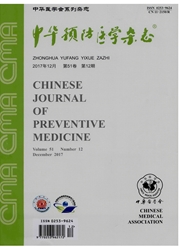

 中文摘要:
中文摘要:
目的探讨并建立湖沼地区钉螺数量的预测模型,为钉螺的定量化研究提供方法学依据。方法在安徽省贵池区秋浦河沿岸随机数字表法随机选择滩地作为研究现场,根据植被类型分层随机抽样,以交叉复核随机抽检法(随机数字表法)调查钉螺,分别用差分GPS仪、T&D Recorder for Windows、卷尺及烘干称重法收集高程、土壤温度(简称土温)和气温、植被高度、土壤湿度(简称土湿)和植被类型6个环境变量信息。对数据进行预处理,通过偏差量和Akaike信息准则比较不同误差分布和连接函数组合的广义线性模型,确定最佳模型结构,建立并验证预测模型效果。结果建模样本量为162框,变量之间存在着复杂的相关性,钉螺数与植被高度呈正相关(r=0.36),与土湿呈负相关(r=-0.22),气温与土温呈正相关(r=0.59),土温与植被高度呈负相关(r=-0.36),土湿与土温和气温均呈负相关(r=-0.34和-0.12)。广义线性模型的最佳结构是以gamma分布为误差分布、倒数为连接函数和均数平方为方差函数的模型结构。模型拟合结果显示高程、土湿、土温、植被类型和植被高度对于预测钉螺的数量有统计学意义,t值分别为-3.202,3.124,-1.989,2.668和-2.371,P值分别为0.00166,0.00214,0.04849,0.00846和0.01897,而气温的作用被土温取代没有进入模型。结论广义线性模型可用于建立钉螺的预测模型,为钉螺的定量化研究提供了广阔的研究前景。
 英文摘要:
英文摘要:
Objective To study the prediction model of O. hupensis in the lake and marshland regions in order to provide methodological basis for quantitative study of O. hupensis. Methods The research sites were randomly selected from the bottomlands along Qiupu River in the Guichi District, Anhui Province. A random and stratified sampling method was administrated according to the type of vegetation ; the frame size of snail survey was 0. 11 m2. Snail data was collected by crosscheck-random sampling inspection survey. Elevation, soil temperature and air temperature, height of vegetation, soil humidity and types of vegetation were measured through GPS machine, T&D Recorder for Windows, tape measure and attemperator. All the data were doubly inputted into the computer and checked. The final dataset for developing the prediction model was set up after necessary data preprocessing, such as, recoding the variable of elevation. The generalized linear models were used to develop the prediction model, and the statistics of deviance and AIC were used to determine the best model structure. Model diagnostics and model evaluation of efficiency were performed with the determined best model structure. Results The sample size was 162, and there were 6 explanatory variable including 2 categorical variables and 4 quantitative variables. A complicated relationship was observed among all the variables. Snail was positively associated with height of vegetation ( r = 0. 36), while negatively associated with soil humidity ( r = - 0. 22 ), and the air temperature had a close positive relations with soil temperature ( r = 0. 59 ), and the soil temperature was negatively associated with height of vegetation ( r = - 0. 36), the soil humidity had negative relations with the soil and air temperature ( r = -0. 34 and - 0. 12 ). The best structure fitting for the liner model selected in gamma distribution was the error distribution, reciprocal as the conjunction function in mathematics, and the mean square as the variance function.
 同期刊论文项目
同期刊论文项目
 同项目期刊论文
同项目期刊论文
 期刊信息
期刊信息
